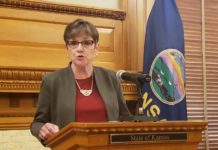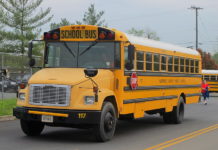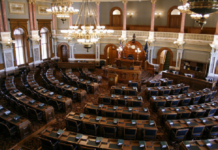(Updated to reflect final vote)
The Kansas Senate on Tuesday agreed to a compromise plan that would change the calculus for school funding in a way that benefits growing school districts, but without suddenly hurting districts with declining student populations.
The Senate voted 33-6 for a compromise that allows school districts to calculate their enrollment based on the current year, the immediately preceding year or an average of the previous two years, whichever is greater.
The change would last for only one year before reverting to using the current year enrollment or the previous year’s enrollment.
The current law allows school districts to base their enrollment on either of the two preceding years, whichever is greater.
Republican lawmakers said the current law puts taxpayers on the hook for students who moved into a new district, but that same student would still be counted for enrollment purposes in the district where they once resided.
“We want the funds to go where the students actually are,” said Republican state Sen. Molly Baumgardner, chair of the Senate Education Committee
As originally proposed, the bill split growing school districts with the districts losing students because of how it would require school funding to be determined.
Of the state’s 286 school districts, 144 have more than 500 students. Seventy-seven districts have 300 or fewer students.
School districts with growing populations say the bill allows them to keep pace with increasing enrollment and cover the cost of new students flowing into their classrooms.
School districts losing students said the current school funding formula – with the two-year look back – provided stability for districts with declining enrollment.
The new plan advanced by the Senate not only gives school districts cushion to plan for any loss of money they would incur in the future, but it also means they lose 50% less than what they might have with the just the one-year look back.
“We do have a lot of districts in this state that are declining enrollment districts,” said Republican state Sen. Brenda Dietrich of Topeka.
“They’re primarily rural, but we have quite a few in the urban core,” she said.
“We just need to think about those districts. Help our growing districts, but not pound too hard on our declining enrollment districts,” she said.
Republican state Sen. Elaine Bowers of Concordia introduced the compromise language.
She said her amendment wouldn’t harm growing schools, but rather would provide a “glide path” for declining enrollment districts that would give them a year to make the necessary budget and staffing adjustments.
“This amendment gives those who will be impacted the most time to adjust,” she said.
The Senate version – as it heads to a final vote Tuesday – is very different from the House plan.
The House bill allows for using the current year enrollment or that of the immediately preceding year. However, implementation of the House bill is delayed until 2025-26.
The Senate plan drew support from the Kansas Association of School Boards, which opposed the original version of the Senate bill.
“We feel we can support the bill now,” said Leah Fliter, lobbyist for the Kansas Associaton of School Boards.
“It gives declining enrollment districts time to plan,” Fliter said.
Last year, Gov. Laura Kelly vetoed a proposal similar to the original Senate legislation that was tucked into the education budget bill.
Kelly said the proposal would have “pulled the rug from underneath rural school districts,” adding that it would have had “dangerous and devastating” consequences.
“I will not allow this to happen to our rural school districts, which are essential to the fabric of Kansas,” Kelly said in her veto message.
“As governor I have always been committed to ensuring that our rural schools are properly supported to serve their communities.
“This provision jeopardizes the vitality of our rural communities and threatens the economic engines of many small towns,” she said.
















